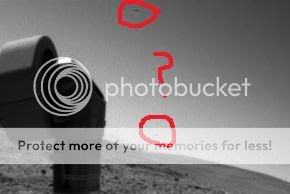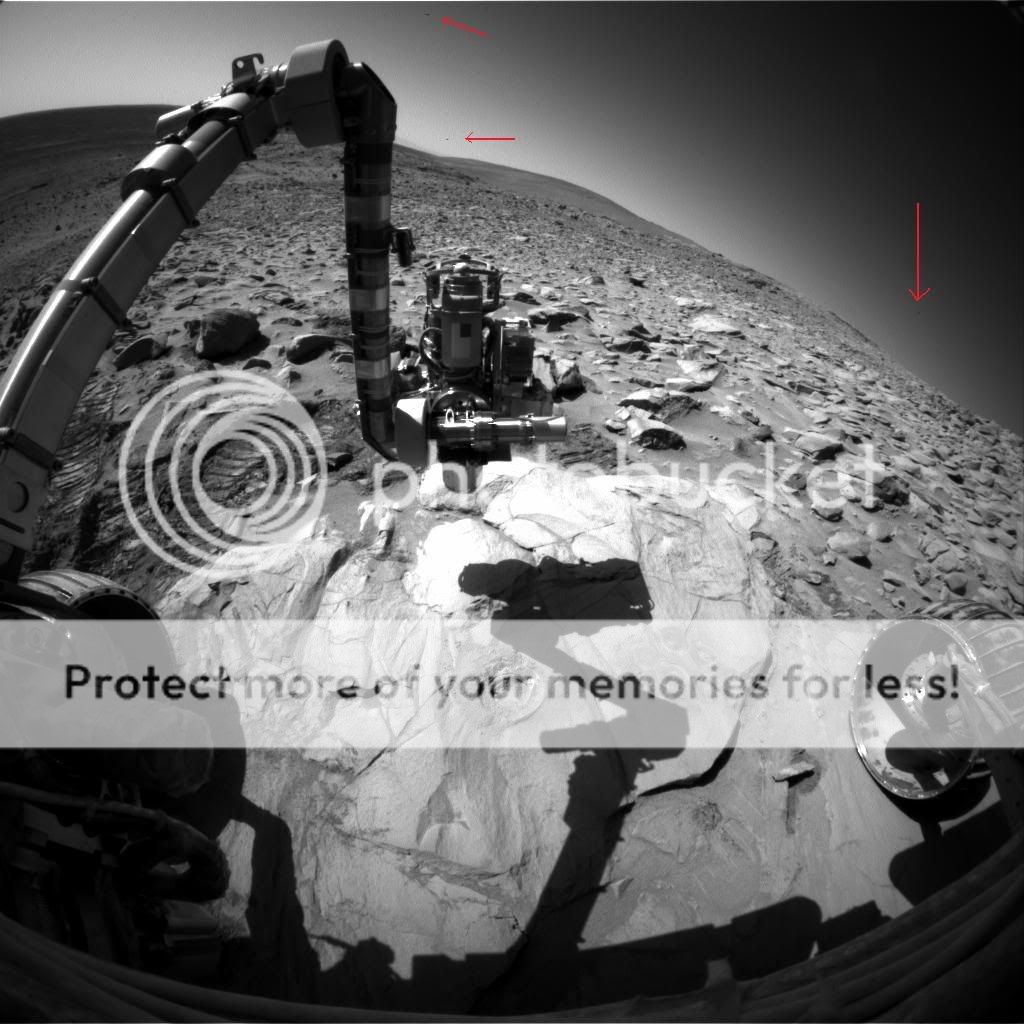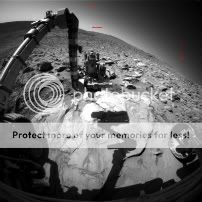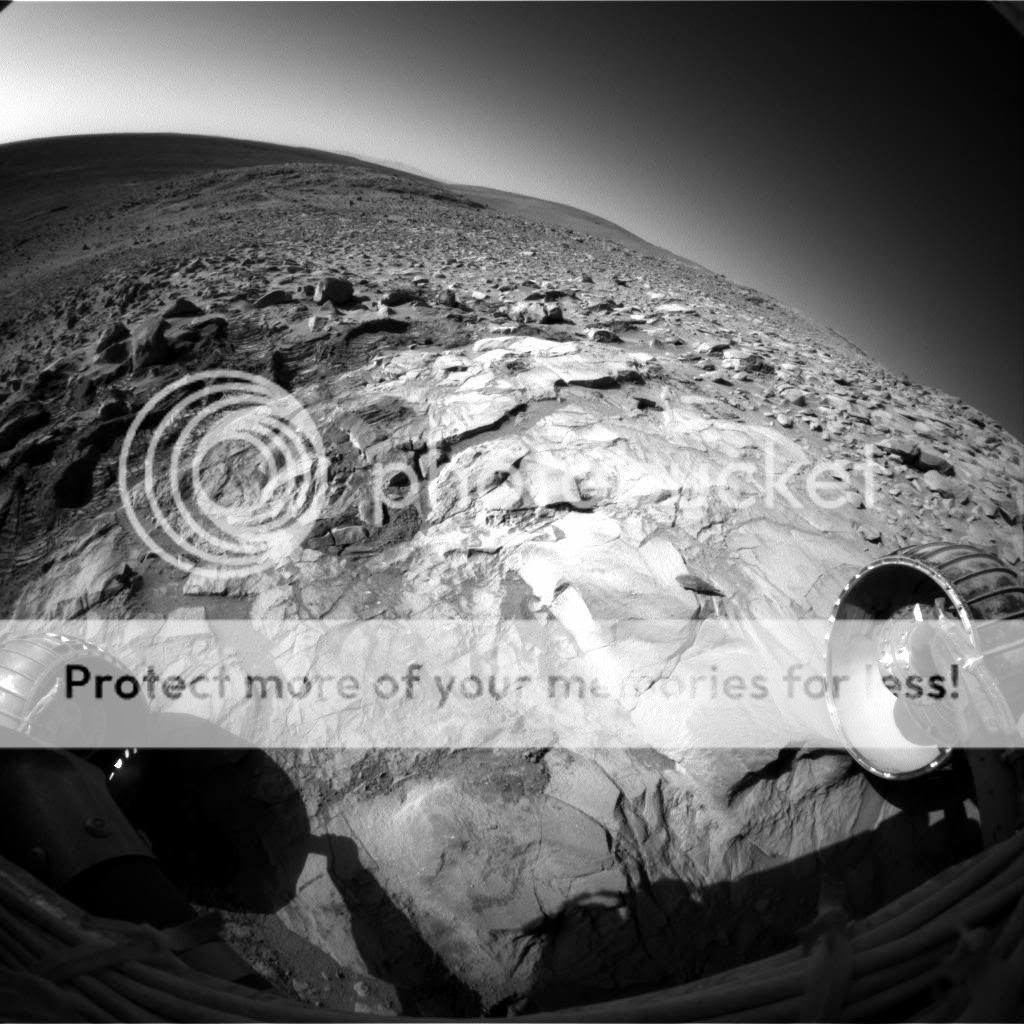It looks like you're using an Ad Blocker.
Please white-list or disable AboveTopSecret.com in your ad-blocking tool.
Thank you.
Some features of ATS will be disabled while you continue to use an ad-blocker.
0
share:
marsrovers.nasa.gov...
At the top, you cant miss it. Maybe its just some dirt, but it looks pretty cool. Let me know what you think.
Debunked, Just some dirt, thanks to "Internos"
[edit on 13-12-2008 by hardcoremusiclover]
[edit on 13-12-2008 by hardcoremusiclover]
At the top, you cant miss it. Maybe its just some dirt, but it looks pretty cool. Let me know what you think.
Debunked, Just some dirt, thanks to "Internos"
[edit on 13-12-2008 by hardcoremusiclover]
[edit on 13-12-2008 by hardcoremusiclover]
It looks like a dust spec on the lens but cant be sure because usually when a dust spec gets on a lens of a camera, its usually out of focus. But I
dont think the nav cam needs to focus becasue of its wide angle type lens.
Its interesting tho! Maybe one of the pancam shots taken shortly after the rover moves off the motherpad may have captured it.
Cheers!!!!
Its interesting tho! Maybe one of the pancam shots taken shortly after the rover moves off the motherpad may have captured it.
Cheers!!!!
Before anyone bashes. Im not saying its a alien space ship. Im just saying its an anomoly(sp) It appears in a few other pictures but not in some.
Weird.
In other nav cam pictures only or both navcam and the pancam shots? How often does this appear and at what intervals of the images?
Cheers!!!!
Cheers!!!!
Ill try to find a link to the album. Ill edit this post when I do.
EDIT: here it is, the album- marsrovers.nasa.gov...
[edit on 13-12-2008 by hardcoremusiclover]

[edit on 13-12-2008 by hardcoremusiclover]
EDIT: here it is, the album- marsrovers.nasa.gov...
[edit on 13-12-2008 by hardcoremusiclover]

[edit on 13-12-2008 by hardcoremusiclover]
It's Spirit Front Hazcam :: Sol 225:
the find is good and thanks for sharing, hardcoremusiclover:
but it's definately dust on the lens:
ive made this animation with:
marsrovers.nasa.gov...
marsrovers.nasa.gov...
marsrovers.nasa.gov...
marsrovers.nasa.gov...
and the object is in the same exact position, despite the Rover even changed orientation:
but as said, it was a nice find
the find is good and thanks for sharing, hardcoremusiclover:
but it's definately dust on the lens:
ive made this animation with:
marsrovers.nasa.gov...
marsrovers.nasa.gov...
marsrovers.nasa.gov...
marsrovers.nasa.gov...
and the object is in the same exact position, despite the Rover even changed orientation:
but as said, it was a nice find
Thank you very much! As I said before, I wasnt claiming it to be some alien ship, just some random thing.
Thank you for taking the time to do that and proving it is just a spec on the lens!
Thank you for taking the time to do that and proving it is just a spec on the lens!
Kind of funny when I clicked on the pick the lower one I thought was dust on my screen and tried to wipe it off, then realized that's what you were
talking about.
there is 3 of those thing in the air, chek this out.


[edit on 13-12-2008 by BIONICLE ALEX]


[edit on 13-12-2008 by BIONICLE ALEX]
well it's an interesting thing ill admit that, but i don't know if it might be a UFO or not.. although id dosent appear to be a smudge or object on
the lens. anyway good picture.
The third one is all the way to the right hand side I just cant get to move the picture to that area, but if you enhance the original photo (not this
one) go all the way to you right you'll see it in the sky as well. 

Originally posted by BIONICLE ALEX
The third one is all the way to the right hand side I just cant get to move the picture to that area, but if you enhance the original photo (not this one) go all the way to you right you'll see it in the sky as well.
Hi, BIONICLE ALEX: i see that too: and it never moves from there, while the Rover changed its angle: this means that it was on the lens: not close, but pasted.
You can check by yourself here:
marsrovers.nasa.gov...
marsrovers.nasa.gov...
marsrovers.nasa.gov...
marsrovers.nasa.gov...
Open all the four images in four different tabs, scroll them to the very right, and open them in sequence: the object sticks there
Originally posted by hardcoremusiclover
Thank you very much! As I said before, I wasnt claiming it to be some alien ship, just some random thing.
Thank you for taking the time to do that and proving it is just a spec on the lens!
You are welcome
Yes, i've appreciated your wise choice of the title, unlike many do, (adding for example multiple exclamation marks and terms like AMAZING etc): in this way, you will always be taken seriously, at least by me. Besides, in these photos this type of find is always worthy some study, becase unlike the photos taken on Earth, you can rule straight out much stuff (i.e. bugs, planes, balloons, birds etc) so if it's not some glitch/dust/defect, of course it can be very interesting.
I look forward to the your next tread, and thanks again for sharing
[edit on 13/12/2008 by internos]
I don't think is dust or any particles on the lens, look closely at this photo? the object is not there any more. As well as for the other photos, I
was examine it and nothing, It looks like what ever it was it just disappear from the Rovers vision.




Originally posted by BIONICLE ALEX
I don't think is dust or any particles on the lens, look closely at this photo? the object is not there any more. As well as for the other photos, I was examine it and nothing, It looks like what ever it was it just disappear from the Rovers vision.
And this is NORMAL in mars rovers images: dust comes and go: i've seen hundreds of situation like this.
While it is IMPOSSIBLE that an actual object is at the same exact relative coordintes in two or MORE (like in this case) shots taken toward two or MORE different directions: or can you explain that and think it's normal? Did the flying object tracked the rover's lens?
Originally posted by internos
Originally posted by BIONICLE ALEX
I don't think is dust or any particles on the lens, look closely at this photo? the object is not there any more. As well as for the other photos, I was examine it and nothing, It looks like what ever it was it just disappear from the Rovers vision.
And this is NORMAL in mars rovers images: dust comes and go: I've seen hundreds of situation like this.
While it is IMPOSSIBLE that an actual object is at the same exact relative coordinates in two or MORE (like in this case) shots taken toward two or MORE different directions: or can you explain that and think it's normal? Did the flying object tracked the rover's lens?
So what your saying is that whe can't trust what ever the Rover captures on his lens's and the Viking satellite as well? so whats the use of waisting billions of dollars up in space if whe can't trust our own High Tech Equipment? All I'm saying is there is 3 objects on those high resolution digital photos and all of isoden it disappear from the Rovers lens. if you look very closely the objects are far away from each other giving us the image of dimensional separation of all 3 objects. All are in different positions same shape different distance, what I mean with dimentional is they are the same object but in different size cause of there distance. if it was any particles at all, all 3 shape wouldn't be perfectly the same shape, am I right?
Originally posted by BIONICLE ALEX
So what your saying is that whe can't trust what ever the Rover captures on his lens's and the Viking satellite as well? so whats the use of waisting billions of dollars up in space if whe can't trust our own High Tech Equipment?
No, this is what YOU are saying: and what has the Viking program to do with this thread? They are totally different programs and are equipped with totally different cameras. Mars Rovers are doing an excellent job, if you ask me, way beyond the expected results.
All I'm saying is there is 3 objects on those high resolution digital photos and all of isoden it disappear from the Rovers lens. if you look very closely the objects are far away from each other giving us the image of dimensional separation of all 3 objects. All are in different positions same shape different distance, what I mean with dimentional is they are the same object but in different size cause of there distance. if it was any particles at all, all 3 shape wouldn't be perfectly the same shape, am I right?
The distance between the objects is relative: they may look to be at some miles one from the other, but they are actually at some inches each other. There is no way to even guess a distance on a 2d image.
Same shape?
Object # 1
Object # 2
Object # 3
This is what was actually caught on camera: these are bigger images, but compressed ones: jpeg artifacting may deform the appearance of everything, so nothing can be said about the precision in representing an object which size is 3x3 pixels
For example, look at the patterns in this image:
We cannot think that they are actual objects, nor that the martian sky is chequered: the smaller is the object, the lower are the chances to see its actual appearance.
I don't know what you mean for "all are in different positions": they are each one stuck in their relative position, relatively to the edges of the images, hence to the lens: each one of them never moved, they just appeared and disappeared.
The same thing may happen in case of some bad data processing, but i don't think this is the case because i don't recall to have seen this effect in case of missing data. While we can rule out a scratch on the lens and of course some actual flying objects, this for sure.
But of course, you are free to believe otherwise, i'm not here to convince anyone, just sharing what i can: do you think that they are flying objects?
Well, so be it, it's not a problem for me, all is fine
[edit on 13/12/2008 by internos]
I don't look at this topic as an argument, for me is like a debate. cause I think we are looking for the same answer. Is interesting to listen to a
second opinion, I'm not claiming nothing I'm just saying there is something up there and for sure is not any particles or dust. this is another
method that i use to take a better look and understanding of the photo. what do you think? The object on the first photo on the bottom is a bit cut
away but you can still appreciate the object. I think I am clear about the distance point of view I know you are an intelligent guy and for sure you
understand what I'm saying, come on man.


[edit on 13-12-2008 by BIONICLE ALEX]


[edit on 13-12-2008 by BIONICLE ALEX]
reply to post by BIONICLE ALEX
BIONICLE ALEX --
What Internos is saying is that the "objects" are in the EXACT same location relative to the edges of the picture in each picture.
That strongly suggests that the Objects are simply someting on the lens -- hence the reason for them being in the exact same location "in the frame of the image" every time.
BIONICLE ALEX --
What Internos is saying is that the "objects" are in the EXACT same location relative to the edges of the picture in each picture.
That strongly suggests that the Objects are simply someting on the lens -- hence the reason for them being in the exact same location "in the frame of the image" every time.
Originally posted by Soylent Green Is People
reply to post by BIONICLE ALEX
BIONICLE ALEX --
What Internos is saying is that the "objects" are in the EXACT same location relative to the edges of the picture in each picture.
That strongly suggests that the Objects are simply someting on the lens -- hence the reason for them being in the exact same location "in the frame of the image" every time.
He used that little animation to explain at whatever he is trying to do, but if you look closely I used the same photos he used and something is not right, look at the photos I posted is the same one he used his animation with. On the semi last photos you can see that the sky is clear, that is one of the photo he used to make his animation. On the other photo you can see all 3 objects in air. You see my debate? analyze all the photos I posted and check his animation something is very wrong.
[edit on 13-12-2008 by BIONICLE ALEX]
Originally posted by BIONICLE ALEX
He used that little animation to explain at whatever he is trying to do, but if you look closely I used the same photos he used and something is not right, look at the photos I posted is the same one he used his animation with. On the semi last photos you can see that the sky is clear, that is one of the photo he used to make his animation. On the other photo you can see all 3 objects in air. You see my debate? analyze all the photos I posted and check his animation something is very wrong.
Yes, something is very wrong:
Anyway: THESE
marsrovers.nasa.gov...
marsrovers.nasa.gov...
marsrovers.nasa.gov...
marsrovers.nasa.gov...
are the images that i've used for my "little animation", all taken by the LEFT front-hazcam eye:
now please show us WHERE in these images even just one of the three dots is not visible (to you): please refer to the image with a LINK, don't call them "semi last" because not all know what you mean for "semi last": "semi last" of WHAT?
Please, use a link and all we will understand what image you are talking about: and use the LEFT eye of front-hazcam.
Some notes regarding the images we are talking about here:
Engineering Hazcams (Hazard Avoidance Cameras)
Mounted on the lower portion of the front and rear of the rover, these black-and-white cameras use visible light to capture three-dimensional (3-D) imagery. This imagery safeguards against the rover getting lost or inadvertently crashing into unexpected obstacles, and works in tandem with software that allows the rover make its own safety choices and to "think on its own."
The cameras each have a wide field of view of about 120 degrees. The rover uses pairs of Hazcam images to map out the shape of the terrain as far as 3 meters (10 feet) in front of it, in a "wedge" shape that is over 4 meters wide at the farthest distance. It needs to see far to either side because unlike human eyes, the Hazcam cameras cannot move independently; they're mounted directly to the rover body.
mars.jpl.nasa.gov...
mars.jpl.nasa.gov...
we are talking about TWO eyes, not one. What i did, was to choose ONE of the eyes, the LEFT one, since the object in the OP was taken by that.
Sol 225 front hazcam set is composed by seven images:
four taken by the LEFT eye
marsrovers.nasa.gov...
marsrovers.nasa.gov...
marsrovers.nasa.gov...
marsrovers.nasa.gov...
and three taken by the RIGHT one:
marsrovers.nasa.gov...
marsrovers.nasa.gov...
marsrovers.nasa.gov...
when you said that in other images the dust was no longer visible, i thought that you were talking about images even from previous and next sols, but i'm afraid that you have made some comparison between images taken by the left eye and ones taken by the right one: if the dust is in the left eye, then you will NEVER see the same dust in the images taken by the right one.
marsrovers.nasa.gov...
In order to find out which eye caught the photo, you have to look at the character # 24 after the last slash:
for example, this image's file name
marsrovers.nasa.gov...
is
2F146349072EFF8512P1110R0M1.JPG
the character # 24 is a R: hence, it was taken by the RIGHT eye.
this one's,
marsrovers.nasa.gov...
2F146342599EFF8512P1404L0M1.JPG
is a L: hence, it was taken by the LEFT one.
More informations HERE.
Oh, before i forget
in THIS image, taken TWO DAYS BEFORE, the "ufos" wer already there. These martians can be very patient when they are observing someone.
[edit on 14/12/2008 by internos]
new topics
-
Mass Extinctions May Hold the Key to Life in the Universe
Education and Media: 1 hours ago -
Can we be certain that Jesus Christ was born on December 25th?
Religion, Faith, And Theology: 4 hours ago -
RIP Merrily Harpur British Big Cat Realist
Cryptozoology: 6 hours ago -
Australian mercenary caught and crying as he is a prisoner of war.
Other Current Events: 11 hours ago
top topics
-
Panamanian President-“every square meter” of the Panama Canal belongs to Panama.
New World Order: 12 hours ago, 12 flags -
Australian mercenary caught and crying as he is a prisoner of war.
Other Current Events: 11 hours ago, 10 flags -
NYPD arrests migrant who allegedly set woman on fire on subway train, watched her burn to death
Breaking Alternative News: 15 hours ago, 9 flags -
JILL BIDEN Wants JOE to Punish Democrats Who Forced Him to Leave Office in Disgrace on 1.20.2025.
2024 Elections: 12 hours ago, 9 flags -
RIP Merrily Harpur British Big Cat Realist
Cryptozoology: 6 hours ago, 6 flags -
Mass Extinctions May Hold the Key to Life in the Universe
Education and Media: 1 hours ago, 3 flags -
Can we be certain that Jesus Christ was born on December 25th?
Religion, Faith, And Theology: 4 hours ago, 1 flags
active topics
-
NYPD arrests migrant who allegedly set woman on fire on subway train, watched her burn to death
Breaking Alternative News • 25 • : Flyingclaydisk -
Can we be certain that Jesus Christ was born on December 25th?
Religion, Faith, And Theology • 18 • : FullHeathen -
F-18 shot down over Red Sea....by our own Destroyer?
Other Current Events • 13 • : Cosmo14 -
Panamanian President-“every square meter” of the Panama Canal belongs to Panama.
New World Order • 19 • : FullHeathen -
Mass Extinctions May Hold the Key to Life in the Universe
Education and Media • 1 • : BeyondKnowledge3 -
Australian mercenary caught and crying as he is a prisoner of war.
Other Current Events • 32 • : BedevereTheWise -
‘Something horrible’: Somerset pit reveals bronze age cannibalism
Ancient & Lost Civilizations • 19 • : Scratchpost -
RIP Merrily Harpur British Big Cat Realist
Cryptozoology • 2 • : angelchemuel -
The Daily Mail trying to imply “it’s aliens”
Dissecting Disinformation • 15 • : crayzeed -
Post A Funny (T&C Friendly) Pic Part IV: The LOL awakens!
General Chit Chat • 7947 • : underpass61
0







